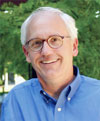April 11, 2005 - By Stanford Program

Richard Popp, MD
National Institutes of Health Director Elias Zerhouni has recently announced a ban on consulting with industry for intramural NIH investigators, based on deep concern about the nature and extent of the consulting activities and the failure of some NIH investigators to report their consulting relationships. Editorials in the media, including the Los Angeles Times, have suggested that this prohibition should apply to all investigators who receive NIH funding.
We share the view reflected in the Feb. 9 Medical Center Report interview of Mildred Cho that the series of events at the NIH is a lamentable situation. But the forces that are now set in motion could have profound implications for Stanford - going right to the heart of our mission of 'translating discoveries' for health.
We have serious concern that the discussions to date have ignored the distinction between productive consulting and inappropriate conflict of interest. We would like to encourage thoughtful and balanced consideration of the issues and their implications for Stanford. Potential or perceived conflict of interest is a fact of life in any university involved in invention and discovery of new technologies and therapies. This state of affairs is clearly outlined in the Stanford faculty handbook:
'Conflicts of interest are common and practically unavoidable in a modern research university. At Stanford, conflicts of interest can arise out of the fact that a mission of the University is to promote public good by fostering the transfer of knowledge gained through University research and scholarship to the private sector. Two important means of accomplishing this mission include faculty consulting and the commercialization of technologies derived from faculty research.'
It is worth noting that the issues surrounding commercialization of technologies invented by faculty members are generally distinct from - and less controversial - than the issues surrounding consulting activities. Federal law, in the form of the Bayh-Dole amendment of 1980, specifies that individual faculty members should receive compensation for an invention, along with the university or other research organization. Although royalties or other forms of payment can be viewed as creating conflicts of interest, the law implicitly acknowledges the overriding importance of providing a financial incentive for the individual to invent.

Paul Yock, MD
There is no comparable federal guidance in the situation in which a faculty member consults with a company to assist in the further development, testing, evaluation or education related to a product. This kind of partnership is deeply embedded in our system of medical research and education. From a practical standpoint, consulting is the primary way that faculty or staff members learn about the way that drugs, devices and other products are brought to market. It is also the way that we learn what types of inventions and discoveries have the potential to be developed into products in the first place. This kind of knowledge is central to the mission of translational medicine. Unfortunately, learning by consulting puts us in a fundamental bind: if faculty members interact closely with industry, conflict-of-interest issues will inevitably arise.
To suggest that faculty should simply 'take the high road' and completely abandon paid consulting relationships carries with it its own set of important risks. A considerable part of Stanford's greatness has to do with our track record as a source of innovative technology. Honest, careful and productive interaction with industry is a part of our university's culture - beginning with the investment by then-Dean of Engineering Frederick E. Terman in his young grad students, Bill Hewlett and Dave Packard.
Given Stanford's high profile in technology innovation, questions will likely arise about our interactions with industry. We need to make an effective case both for how well the interaction between the university and industry has worked in the past and for how important it is for continued innovation in health care. In our opinion, for Stanford or any university to continue to serve its optimal role in developing new technologies and therapies, it is essential to maintain and encourage a robust network of faculty relationships with industry.
At the same time, it is urgent that we take steps to recognize, minimize and manage apparent conflicts of interest when they occur as part of our mission for technology transfer. We must eliminate situations of inappropriate conflict of interest that violate university policy. The School of Medicine has just posted on its Web site a simple and practical guide to avoiding problematic conflict of interest, with specific advice for those who have, or are considering, relationships with industry (Tips For Avoiding Conflicts of Commitment and Interest).
Clearly, the reputations of the university and of individual faculty members, staff and students are our most valued assets. We believe Stanford personnel become better university citizens through their relationships with industry colleagues. The Faculty Policy on Conflict of Commitment and Interest reflects a balanced assessment of the risks and rewards of university-industry interactions. In light of the current atmosphere regarding these issues, it is incumbent upon all faculty, staff and students to understand and follow the policy - not just for personal protection, but to safeguard a system that creates the potential for effective technology innovation and translation.
This essay was coauthored by the members of the executive committee of the Stanford Program in Biodesign: Thomas Andriacchi, PhD; Scott L. Delp, PhD; Thomas M. Krummel, MD; Joshua Makower, MD; Craig Milroy, MS; Richard L. Popp, MD; Charles Taylor, PhD, and Paul G. Yock, MD.
About Stanford Medicine
Stanford Medicine is an integrated academic health system comprising the Stanford School of Medicine and adult and pediatric health care delivery systems. Together, they harness the full potential of biomedicine through collaborative research, education and clinical care for patients. For more information, please visit med.stanford.edu.